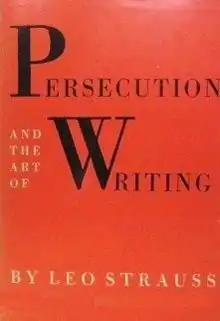Persecution and the Art of Writing
Persecution and the Art of Writing, published in 1952 by the Free Press, is a book of collected articles written by Leo Strauss.[1] The book contains five previously published essays, many of which were significantly altered by Strauss from their original publication. The general theme of the book is the relationship between politics and philosophy. The thesis of the book is that many ancient and early modern political philosophers, in order to avoid persecution, hid their most heterodox ideas within their texts.

Overview
Strauss's general argument—rearticulated throughout his subsequent writings (most notably in The City and Man – 1964)—is that prior to the 19th century, Western scholars commonly understood that philosophical writing is not at home in any polity, no matter how liberal. Insofar as it questions conventional wisdom at its roots, philosophy must guard itself especially against those readers who believe themselves authoritative, wise, and liberal defenders of the status quo. In questioning established opinions, or in investigating the principles of morality, philosophers of old found it necessary to convey their messages in an oblique manner. Their "art of writing" was the art of esoteric communication. This is all the more apparent in medieval times, when heterodox political thinkers wrote under the threat of the Inquisition or comparably intransigent tribunals.
Strauss's argument is not that the medieval writers he studies reserved one exoteric meaning for the many (hoi polloi) and an esoteric or hidden one for the few (hoi aristoi, literally "the best") but rather that their writings' respective core meanings extended beyond and were irreducible to their texts' literal and/or historical dimension.
Explicitly following Gotthold Ephraim Lessing's lead, Strauss indicates that medieval political philosophers, no less than their ancient counterparts, in writing, carefully adapted their wording to the dominant moral views of their time, lest their writings be condemned as heretical or unjust, not by "the many" (who did not read), but by those "few" whom the many regarded as the most righteous guardians of morality: precisely those few righteous personalities would be most inclined to persecute or ostracize anyone who is in the business of exposing the "noble" or "great lie" upon which stands or falls the authority of the few over the many. Strauss thus presents Maimonides "as a closet nonbeliever obfuscating his message for political reasons."[2]
Editions
- Leo Strauss, Persecution and the Art of Writing. Glencoe, Ill.: The Free Press, 1952. Reissued Chicago: University of Chicago Press, 1988. ISBN 978-0-226-77711-5
References
- Eugene Sheppard (7 October 2014). "4". Leo Strauss and the Politics of Exile: The Making of a Political Philosopher. Brandeis University Press. ISBN 978-1-61168-769-9.
- Michael Paley and Jacob J. Staub in Jewish Philosophy: Medieval and Modern, printed in The Schocken Guide to Jewish Books (1992) p. 215.
Further reading
- Leo Strauss, Lecture Notes for 'Persecution and the Art of Writing'. Critical edition by Hannes Kerber. Published in Yaffe/Ruderman (ed.): Reorientation: Leo Strauss in the 1930s. New York, NY.: Palgrave Macmillan, 2014, pp. 293–304.